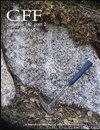New results of stable isotope and petrographic studies of Jurassic glendonites from Siberia
IF 1.2
4区 地球科学
Q2 GEOLOGY
引用次数: 6
Abstract
ABSTRACT We present the results of an optical microscopy, cathodoluminoscopy and isotopic study on nine glendonite concretions (calcite pseudomorphs replacing metastable hexahydrate ikaite) from Lower-Middle Jurassic sediments of Northeast Russia (Anabar Bay and Lena River region). Glendonite concretions are mainly found within Late Pliensbachian, Toarcian, Aalenian, Bajocian and Lower Bathonian clastic sediments, correlating to episodes of global climatic cooling as determined by independent paleoclimate proxy data. Stable carbon and oxygen isotopic values of glendonite concretions suggest that the primary source of carbon was derived from diagenetically altered organic matter, and the source of oxygen was from seawater. The secondary diagenetic cement is characterized by a significantly lighter δ18O and significantly heavier δ13C signature than the isotopic characteristics of the bulk rock glendonite concretion. This secondary diagenetic cement is thought to have precipitated rapidly during burial diagenesis and since it occupies a significant volume of the glendonite concretion, it has the potential to significantly influence the isotopic composition of bulk rock glendonites.西伯利亚侏罗系榴辉岩稳定同位素及岩石学研究新结果
摘要本文报道了俄罗斯东北部(阿纳巴尔湾和勒拿河地区)中下侏罗统沉积物中9个绿榴石结核(方解石伪晶代替亚稳六水岩)的光学显微镜、阴极发光显微镜和同位素研究结果。绿榴石结核主要存在于晚Pliensbachian、Toarcian、Aalenian、bajoian和下Bathonian碎屑沉积物中,与独立的古气候代用资料确定的全球气候变冷事件有关。绿榴石结核的碳、氧同位素稳定值表明碳的主要来源为成岩蚀变有机质,氧的主要来源为海水。次生成岩胶结物的δ18O和δ13C同位素特征明显轻于块状绿榴石胶结物。这种次生成岩胶结物被认为是在埋藏成岩作用过程中迅速沉淀的,由于它占据了格兰榴石结核的很大体积,因此它有可能显著影响大块岩石格兰榴石的同位素组成。
本文章由计算机程序翻译,如有差异,请以英文原文为准。
求助全文
约1分钟内获得全文
求助全文
来源期刊

Gff
地学-地质学
CiteScore
2.80
自引率
10.00%
发文量
11
审稿时长
>12 weeks
期刊介绍:
GFF is the journal of the Geological Society of Sweden. It is an international scientific journal that publishes papers in English covering the whole field of geology and palaeontology, i.e. petrology, mineralogy, stratigraphy, systematic palaeontology, palaeogeography, historical geology and Quaternary geology. Systematic descriptions of fossils, minerals and rocks are an important part of GFF''s publishing record. Papers on regional or local geology should deal with Balto-Scandian or Northern European geology, or with geologically related areas. Papers on geophysics, geochemistry, biogeochemistry, climatology and hydrology should have a geological context. Descriptions of new methods (analytical, instrumental or numerical), should be relevant to the broad scope of the journal. Review articles are welcome, and may be solicited occasionally. Thematic issues are also possible.
 求助内容:
求助内容: 应助结果提醒方式:
应助结果提醒方式:


